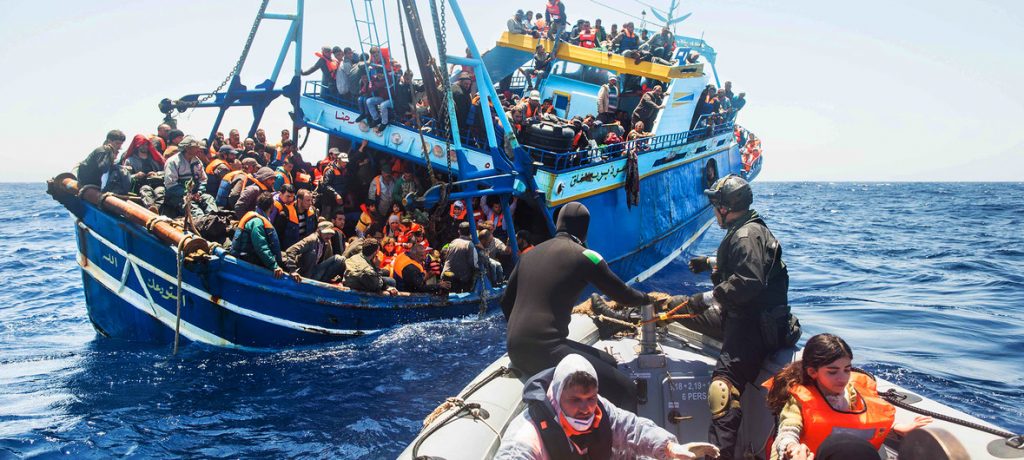By Akanimo Sampson
The Mediterranean Sea has so far claimed the lives of at least 19,164 migrants since 2014, according to a report by the International Organisation for Migration (IOM), the migration agency of the United Nations.
The sea is, however, connected to the Atlantic Ocean, surrounded by the Mediterranean Basin and almost completely enclosed by land: on the north by Southern Europe and Anatolia, on the south by North Africa and on the east by the Levant. Although the sea is sometimes considered a part of the Atlantic Ocean, it is usually referred to as a separate body of water.
According to Wikipedia, geological evidence indicates that around 5.9 million years ago, the Mediterranean was cut off from the Atlantic and was partly or completely desiccated over a period of some 600,000 years (the Messinian salinity crisis) before being refilled by the Zanclean flood about 5.3 million years ago.
Continuing, the free encyclopedia says the sea covers an area of about 2.5 million square kilometres (0.97×106 sq mi), representing 0.7% of the global ocean surface, but its connection to the Atlantic via the Strait of Gibraltar—the narrow strait that connects the Atlantic Ocean to the Mediterranean Sea and separates Spain in Europe from Morocco in Africa—is only 14 km (9 mi) wide. In oceanography, it is sometimes called the Eurafrican Mediterranean Sea or the European Mediterranean Sea to distinguish it from Mediterranean seas elsewhere.
“The Mediterranean Sea has an average depth of 1,500 m (4,900 ft) and the deepest recorded point is 5,267 m (17,280 ft) in the Calypso Deep in the Ionian Sea. It lies between latitudes 30° and 46° N and longitudes 6° W and 36° E. Its west-east length, from the Strait of Gibraltar to the Gulf of Iskenderun, on the southwestern coast of Turkey, is about 4,000 kilometres (2,500 mi).
“The sea was an important route for merchants and travellers of ancient times, facilitating trade and cultural exchange between peoples of the region. The history of the Mediterranean region is crucial to understanding the origins and development of many modern societies.
“The countries surrounding the Mediterranean in clockwise order are Spain, France, Monaco, Italy, Slovenia, Croatia, Bosnia and Herzegovina, Montenegro, Albania, Greece, Turkey, Syria, Lebanon, Israel, Egypt, Libya, Tunisia, Algeria, and Morocco; Malta and Cyprus are island countries in the sea. In addition, the Gaza Strip and the British Overseas Territories of Gibraltar and Akrotiri and Dhekelia have coastlines on the sea,’’ says Wikipedia.
However, deaths recorded on the three main Mediterranean Sea routes through 2019, according to IOM, are at 1,283 individuals—or about 44% of the 2,299 deaths confirmed during the same period in 2018.
Missing Migrants Project
2019 is the sixth year of IOM’s efforts to systematically record deaths on migration routes worldwide through its Missing Migrants Project. Since the beginning of 2014, the project has recorded the deaths of 34,532 people, including 3,368 in 2019.
On the other hand, the total number of 110,669 migrants and refugees who entered Europe by sea during the year is also slightly below the 116,273 men, women and children who crossed the Mediterranean in 2018, a decline of about five per cent.
The UN agency reported on Friday, marking the sixth straight year that at least 100,000 arrivals were recorded on three Mediterranean Sea Routes.
| Global Migrant Deaths Jan 1 – December 31 (Source: Missing Migrants Project) |
||||
| REGION | 2019 | 2018 | ||
| Mediterranean | 1,283* | 2,299 | ||
| Europe | 132 | 116 | ||
| Middle East | 158* | 145 | ||
| North Africa | 319* | 737 | ||
| Horn of Africa | 99* | 276 | ||
| Sub-Saharan Africa | 331* | 589 | ||
| Central Asia | 0 | 52 | ||
| Southeast Asia | 143* | 102 | ||
| South Asia | 111* | 27 | ||
| East Asia | 5 | 3 | ||
| North America | 1 | 1 | ||
| US-Mexico border | 479* | 444 | ||
| Central America | 110 | 77 | ||
| Caribbean | 160 | 41 | ||
| South America | 37 | 30 | ||
| TOTAL | 3,368 | 4,939 | ||
| * More incidents may be reported in the coming days. | ||||
Since 2014, the Mediterranean’s central route between North Africa and Italy remains the region’s deadliest corridor. Missing Migrants researchers estimate one in 33 people died attempting to cross the Central Mediterranean in 2019, compared to one in 35 in 2018 and one in 51 in 2017.
Though the number of deaths recorded fell from 2,299 in 2018 to 2,183 in 2019, these figures do not include a rising number of shipwrecks still yet to be confirmed, according to data collected by IOM’s Missing Migrants Project, based at IOM’s Global Migration Data Analysis Centre (GMDAC) in Berlin, Germany.

